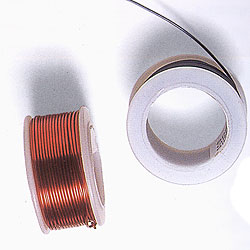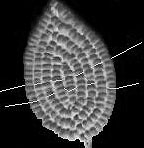Wire
Metal wire for Jewelry Making

Metal Jewelry Wire comes in a diverse range of colours, finishes, base metals, and sizes/gauges. Wires are handy not just for beaded projects (lke beaded flowers) but a whole gamut of craft items and most of all, in the intirguing wire jewelry arena. See Wire Jewelry Making techniques for some essential and fun how-tos.
 (aka Jewelry Wire, Metal Wire)
(aka Jewelry Wire, Metal Wire)
In dealing with wire, you will almost always find it handy to know the gauge and have some wire gauge conversion table to guide you as the thickness of wire is quoted equally in terms of its gauge, or its diameter thickness in inches or millimeters.
Wires, from many bead supplies stores, are either in copper, brass, silver, gold, silver or gold plated wires, and colour-coated wires.
Silver-plated round wire is an excellent wire to use for practice and is widle used in many designs. The 22 and 20 gauge wires are the most common and are particularly good as multipurpose wires.
Fine gauge wires are generally too fine and fragile for anything other than decoration purposes.The thicker wires can be used to create stunning, dramatic effects but they are also more difficult to work with.
Coloured wires are excellent to increase the range of your design potential. Be aware tho that they can mark while you work with them. The colour can also wear off with heavy use.
Precious Metal Wires
If you are thinking of working with precious metal wires, look for the "half hard" variety rather than the very soft ones. The former is easier to work with and yielf more precise work. The very soft wires can "drift" during work, producing less precise workmanship.
- Always protect your eyes when cutting the ends of wire.
- Use generous length of wire in your work to avoid having to struggle with short ends, which can hurt your fingers.
- Cut ends of precious metal wires can be kept and later melted down for other uses.
General Usages by Wire Thickness
32 Gauge Wire
This is also called "Lacing Wire". It is very fine - about as thick as standard sewing threads and has about the same strength. It has to be kept as straight as possible at all times as it will break very easily when kinked. Though you could cut it with a pair of scissors, it will ruin your scissor's edge. Use a simple wire cutter instead.
 This is called "Lacing Wire" because, due to its fineness, it is ideal for lacing together rows of beads (e.g. in making beaded leaves or flowers). It is so fine that if you use a matching colour, you can use the 32 gauge wire to weave between rows, and the lacing wire will blend nicely in. After ending it off, you can weave the remain ends back into the closest bead to hide the ends.
This is called "Lacing Wire" because, due to its fineness, it is ideal for lacing together rows of beads (e.g. in making beaded leaves or flowers). It is so fine that if you use a matching colour, you can use the 32 gauge wire to weave between rows, and the lacing wire will blend nicely in. After ending it off, you can weave the remain ends back into the closest bead to hide the ends.
26, 24, and 22 Gauge Wires
For craftwork like beaded flowers, leaves, and petals, these gauges are the best to work with.
If you are using steel wire, then gauge 26 or 24 is better as the thicker gauge 22 might be a bit too stiff for the fingers.
If using soft wire or precious metal wire, then gauge 24 or 22 would work better. The thinner gauge 26 wire might prove too weak and floppy.
You will need wire cutters to cut these wires if you do not want to destroy your scissors.
These 3 gauges normallly will fit size 10 and 11 beads comfortably.
18 Gauge Wire
also called "Stem Wire"
as this is the gauge that is most commonly used to form stems when attaching leaves, flowers and petals in beaded floral works.
18 gauge can be bent with the hands but you will really need looping pliers to form loops and proper angles.
Back to JewelryMaking-Beads-Library Home
Back to Threads and Stringing Materials
Back to top of this Jewelry Wire

Like This Page?
New! Comments
Have your say! Leave a comment or suggestion in the box below.